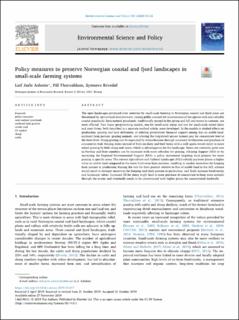| dc.description.abstract | The open landscapes produced over centuries by small-scale farming in Norwegian coastal and fjord areas are threatened by agricultural abandonment, raising public concern for maintenance of the species-rich and valuable coastal grasslands. Semi-natural grasslands, traditionally grazed in the spring and fall and mown in summer, are most affected. Two linear programming models, one for small-scale sheep and one for small-scale mixed dairy and meat farms, both described in a separate method article, were developed. In the models is studied effects on production, grazing and land utilization, of altering government financial support among leys on arable land, enclosed farm pasture, grazing animals, and altering the (regulated) prices farmers pay for concentrate feed at the farm level. Sheep grazing can be expanded by intensification through increased fertilization and purchase of concentrate feed. Raising steers instead of bulls on dairy and beef farms with a milk quota would result in more mixed grazing by both sheep and steers, which is advantageous for the landscape. Steers are currently quite rare in Norway and their numbers can be increased with more subsidies for grazing, (Grazing Support (GS)) or by increasing the Regional Environmental Support (RES), a policy instrument targeting local projects for more grazing in specific areas. The current Agriculture and Cultural Landscape (ACL) subsidy payment places a higher value on arable land compared to the more biodiverse farm pastures, resulting in weaker incentives for keeping farm pasture in production. Raising the rate for farm pasture relative to that of arable land in the ACL scheme would result in stronger incentives for keeping such farm pasture in production, and likely increase biodiversity and landscape values. Increased GS for sheep might lead to more purchase of concentrate to keep more animals through the winter and eventually needs to be counteracted with higher prices for concentrated feedstuffs. | en_US |

